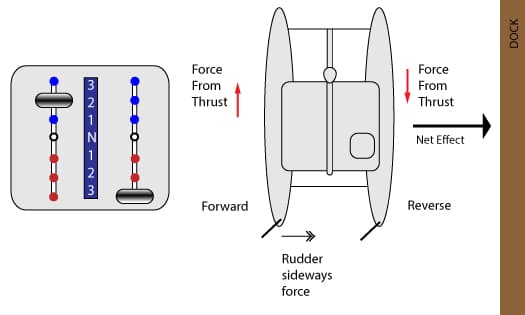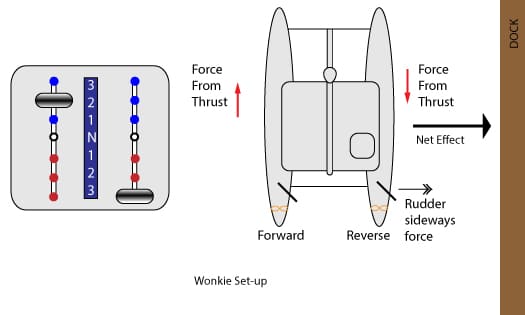Advanced Catamaran Maneuvering – Using the Rudders
Rudder Position v. Propeller Position
There are some other cool things you can do when you consider the propeller thrust over the rudders. However, there is an added complexity. For some unknown reason other than design for space and fit, some manufacturers thought it was a good idea to put the rudder IN FRONT of the propeller instead of behind like you would expect from a normal monohull. GRRRRRR!
We defined the term for this as a “Wonkie” setup. It’s weird and it doesn’t work as well for maneuvering.
Normal = Rudder behind the propeller
Wonkie = Rudder in front of the propeller
Having the rudder forward of the propeller means when you apply forward thrust with the wheel hard over, you will get no sideways stern kick. Instead, if you put the gear in reverse and put the wheel over, THEN you will get a sideways stern kick. This is going to mess with your head as to which way.
So let’s take a look at that.
Above, a monohull is shown for simplicity because most of us can readily relate to a monohull rudder and propeller wash. Both scenarios of the rudder position v. the propeller position are displayed.
On the left: When the rudder is mounted forward of the propeller, as in some catamarans, only reverse thrust acts on the rudder. In this case, when the wheel is turned to port (which rotates the rudder trailing edge to port), the force on the rudder from the prop wash pushes the stern to port and the boat turns in the opposite direction of the wheel.
On the Right: When the rudder is mounted behind the propeller, as in many catamarans and most all monohulls, only forward thrust acts on the rudder. In this case, when the wheel is turned to port (which rotates the rudder trailing edge to port), the force on the rudder from the prop wash pushes the stern to starboard and the boat turns to port in the same direction as the wheel – as you’d expect and just like a car.
When you are in the thick of it in a busy marina, you need a memorization tool rather than trying to work out all the forces and thrust directions. All you really need to remember is that if you have a wonkie set up (rudder forward) (1) only reverse thrust works on the rudder and (2) whatever wheel direction you turn, the bow goes the other direction. And come to think of it, it’s the same as a car in reverse also.
Normal rudder setup = normal turning
Wonkie rudder set up = wonkie turning
That’s easy to remember:
- with a wonkie setup, when you put the thrust in the reverse (onto the rudder) the boat will turn opposite the wheel.
- with a normal setup, when you put the thrust in forward (onto the rudder) the boat will turn the same as the wheel. (i.e. steering a car going forward – normal)
What is also worth noting about a wonkie setup is that during normal marine maneuvering operations, you’ll have to use the throttle bulldozer effect a lot more. This is because until you get a lot of water flowing over the rudders from boat speed, you just won’t get any turning power. You can’t just go wheel over and both throttles forward to get the sideways thrust kick you are used to. You are forced to use a combination of forward thrust on one engine with reverse thrust on the other to make any turns at slow speed. Which isn’t that bad because the bulldozer method is very effective.
If you’re left a wee bit confused from the above, that’s ok. The point was to make you aware of the different setups, give you the theory behind the maneuvering, and give you an easy memorization tool.
Below we give you some further graphics and animations so that you can see and experience the differences and learn how to maneuver each type of configuration.
Rudders Forward of the Propellers (wonkie).
The above image shows the configuration where the rudders are forward of the propellers
Rudders Aft of the Propellers (normal for monohull people).
The above image shows the configuration where the rudders are aft of the propellers
Real Exercises
Here are some exercises to try out on the water to observe the movements for real.
 Exercise M10-2
Exercise M10-2
- Find out if your rudder setup is normal or wonkie.
- With engines in neutral, put the wheel hard over in any direction.
- Apply a forward thrust 2-second burst to 2500 rpm on both engines and observe the boat’s behavior.
- Apply a reverse thrust 2-second burst to 2500 rpm on both engines and observe the boat’s behavior.
 What You Observed
What You Observed
- If normal, the boat reacted to the forward thrust to turn the boat in the same direction as the wheel. The boat made no reaction with a reverse burst.
- If wonkie, the boat reacted to the reverse thrust to turn the boat in the opposite direction as the wheel. The boat made no reaction with a forward burst.
Advanced Maneuvering
Now that we know more about rudder forces, let’s look at how to really maneuver a Catamaran using thrust and rudders.
While the Catamaran has two hulls, two engines, two rudders, and sometimes two wheels, both rudders will always work in unison and turn in the same direction. The rudders do not operate independently – even if there are two helm wheels – whew!
View the animation below. This assumes the boat is moving forward through the water under sail or power with engines in forward.
When moving forward through the water and using both throttles equally the Catamaran turns much like a monohull.
Unlike a monohull, however, there is another variable of prop wash that can work independently on each rudder. This can give an advantage of being able to maneuver the Catamaran sideways.
For example with a normal setup: With the wheel to port and the port throttle slightly forward and starboard throttle back, the boat will vector sideways to starboard. Port-side water thrust will act on the port rudder while there is no thrust wash over the starboard rudder because that engine is in reverse.
The principle here is that the boat wants to spin clockwise but the thrust on the port rudder is pushing the stern of the boat to starboard. Thus, the effect vectors the boat sideways. Makes sense right? In a monohull, if you wanted to kick the stern towards the dock, you’d turn the wheel away from the dock. Combine this with using the bulldozer effect to turn the bow to the dock and you get sideways force.
Here is an animation to show the same effect (just for fun) (assuming a normal rudder propeller setup).
There is an easy way to remember this: Use the bulldozer effect to turn the bow to the dock and turn the wheel away from the dock. Use various combinations of throttle to get the boat moving exactly sideways.
For a wonkie set up here is what you would expect. You still bulldozer the bow to the dock and you use wonkie reverse thrust to push the stern to the dock by turning the wheel to the dock.
A word of note and caution: The sideways vectoring trick IS NOT powerful enough to overcome the effect of wind. You can not vector upwind using this method.


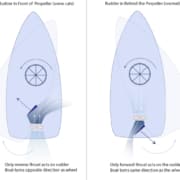
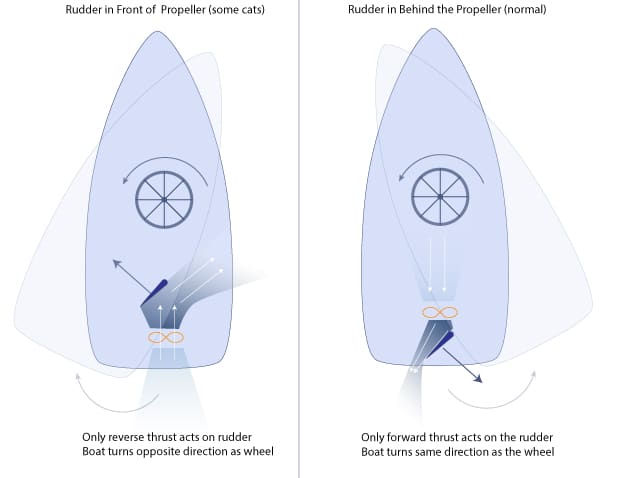
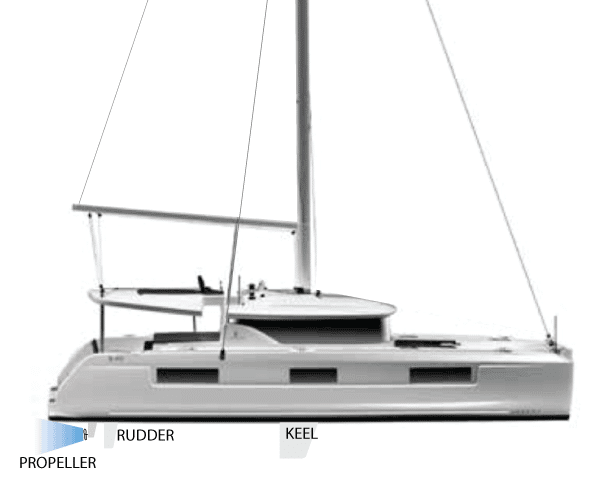
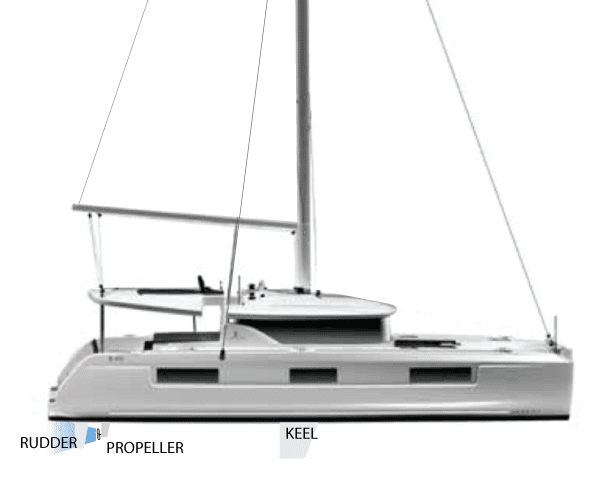
 Exercise M10-2
Exercise M10-2 What You Observed
What You Observed